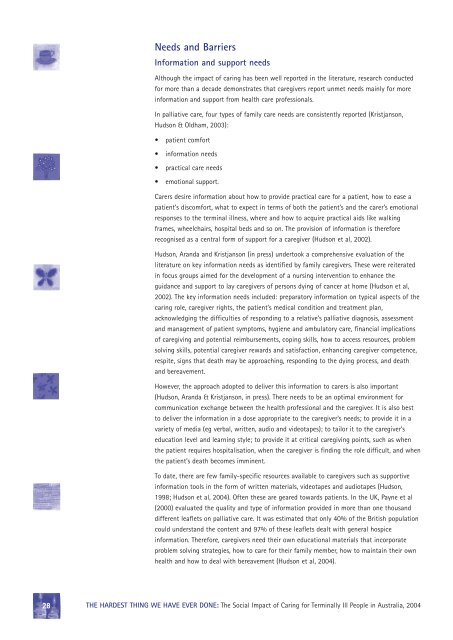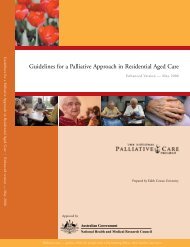The hardest thing we have ever done - Palliative Care Australia
The hardest thing we have ever done - Palliative Care Australia
The hardest thing we have ever done - Palliative Care Australia
Create successful ePaper yourself
Turn your PDF publications into a flip-book with our unique Google optimized e-Paper software.
Needs and Barriers<br />
Information and support needs<br />
Although the impact of caring has been <strong>we</strong>ll reported in the literature, research conducted<br />
for more than a decade demonstrates that caregivers report unmet needs mainly for more<br />
information and support from health care professionals.<br />
In palliative care, four types of family care needs are consistently reported (Kristjanson,<br />
Hudson & Oldham, 2003):<br />
• patient comfort<br />
• information needs<br />
• practical care needs<br />
• emotional support.<br />
<strong>Care</strong>rs desire information about how to provide practical care for a patient, how to ease a<br />
patient’s discomfort, what to expect in terms of both the patient’s and the carer’s emotional<br />
responses to the terminal illness, where and how to acquire practical aids like walking<br />
frames, wheelchairs, hospital beds and so on. <strong>The</strong> provision of information is therefore<br />
recognised as a central form of support for a caregiver (Hudson et al, 2002).<br />
Hudson, Aranda and Kristjanson (in press) undertook a comprehensive evaluation of the<br />
literature on key information needs as identified by family caregivers. <strong>The</strong>se <strong>we</strong>re reiterated<br />
in focus groups aimed for the development of a nursing intervention to enhance the<br />
guidance and support to lay caregivers of persons dying of cancer at home (Hudson et al,<br />
2002). <strong>The</strong> key information needs included: preparatory information on typical aspects of the<br />
caring role, caregiver rights, the patient’s medical condition and treatment plan,<br />
acknowledging the difficulties of responding to a relative’s palliative diagnosis, assessment<br />
and management of patient symptoms, hygiene and ambulatory care, financial implications<br />
of caregiving and potential reimbursements, coping skills, how to access resources, problem<br />
solving skills, potential caregiver rewards and satisfaction, enhancing caregiver competence,<br />
respite, signs that death may be approaching, responding to the dying process, and death<br />
and bereavement.<br />
Ho<strong>we</strong>ver, the approach adopted to deliver this information to carers is also important<br />
(Hudson, Aranda & Kristjanson, in press). <strong>The</strong>re needs to be an optimal environment for<br />
communication exchange bet<strong>we</strong>en the health professional and the caregiver. It is also best<br />
to deliver the information in a dose appropriate to the caregiver’s needs; to provide it in a<br />
variety of media (eg verbal, written, audio and videotapes); to tailor it to the caregiver’s<br />
education level and learning style; to provide it at critical caregiving points, such as when<br />
the patient requires hospitalisation, when the caregiver is finding the role difficult, and when<br />
the patient’s death becomes imminent.<br />
To date, there are few family-specific resources available to caregivers such as supportive<br />
information tools in the form of written materials, videotapes and audiotapes (Hudson,<br />
1998; Hudson et al, 2004). Often these are geared towards patients. In the UK, Payne et al<br />
(2000) evaluated the quality and type of information provided in more than one thousand<br />
different leaflets on palliative care. It was estimated that only 40% of the British population<br />
could understand the content and 97% of these leaflets dealt with general hospice<br />
information. <strong>The</strong>refore, caregivers need their own educational materials that incorporate<br />
problem solving strategies, how to care for their family member, how to maintain their own<br />
health and how to deal with bereavement (Hudson et al, 2004).<br />
28 THE HARDEST THING WE HAVE EVER DONE: <strong>The</strong> Social Impact of Caring for Terminally Ill People in <strong>Australia</strong>, 2004
















